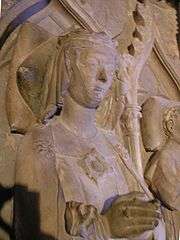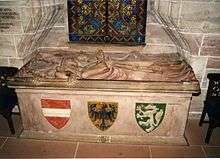Gertrude of Hohenberg
| Gertrude of Hohenberg | |||||
|---|---|---|---|---|---|
 Queen's tomb in Basel Minster | |||||
| Queen consort of Germany | |||||
| Tenure | 1273–1281 | ||||
| Predecessor | Elisabeth of Bavaria | ||||
| Successor | Isabella of Burgundy | ||||
| Born |
c. 1225 Deilingen, Swabia | ||||
| Died |
16 February 1281 Vienna, Austria | ||||
| Burial | Saint Paul's Abbey, Lavanttal | ||||
| Spouse | Rudolph I of Germany | ||||
| Issue | |||||
| |||||
| House | Hohenberg | ||||
| Father | Burkhard V, Count of Hohenberg | ||||
| Mother | Matilda of Tübingen | ||||
Gertrude Anne of Hohenberg (c. 1225 – 16 February 1281) was German queen from 1273 until her death, by her marriage with King Rudolf I of Germany.[1] As queen consort, she became progenitor of the Austrian House of Habsburg.
Biography
Gertrude was born in Deilingen, Swabia to Count Burkhard V of Hohenberg (died 1253) and his wife Matilda (Mechtild), daughter of Count Palatine Rudolf II of Tübingen. The comital Hohenberg dynasty, a cadet branch of the Swabian House of Hohenzollern, then ruled over extended estates in southwestern Germany. Citing contemporary sources, Gertrude's descent was questioned by the Swiss historian Aegidius Tschudi (1505–1572), who postulated a Frohburg lineage; nevertheless, his objections have been disproved.
About 1251 in Alsace, Gertrude married Rudolf (1218–1291), son of Count Albert IV of Habsburg and Heilwig of Kyburg. She went on to live with her husband as a comital couple in Rheinfelden. They had eleven children:
- Matilda (c. 1253, Rheinfelden – 23 December 1304, Munich), married 1273 in Aachen to Louis II, Duke of Bavaria and became mother of Rudolf I, Count Palatine of the Rhine and Louis IV, Holy Roman Emperor.
- Albert I of Germany (July 1255 – 1 May 1308), Duke of Austria and also of Styria.
- Catherine (1256 – 4 April 1282, Landshut), married 1279 in Vienna to Otto III, Duke of Bavaria who later (after her death) became the disputed King Bela V of Hungary and left no surviving issue.
- Agnes [Gertrude] (c. 1257 – 11 October 1322, Wittenberg), married 1273 to Albert II, Duke of Saxony and became the mother of Rudolf I, Duke of Saxe-Wittenberg.
- Hedwig (c. 1259 – 26 January 1285/27 October 1286), married 1270 in Vienna to Otto VI, Margrave of Brandenburg-Salzwedel and left no issue.
- Clementia (c. 1262 – after 7 February 1293), married 1281 in Vienna to Charles Martel of Anjou, the Papal claimant to the throne of Hungary and mother of king Charles I of Hungary, as well as of queen Clementia of France, herself the mother of the baby king John I of France.
- Hartmann (1263, Rheinfelden – 21 December 1281), drowned in Rheinau.
- Rudolf II, Duke of Austria and Styria (1270 – 10 May 1290, Prague), titular Duke of Swabia, father of John the Patricide of Austria.
- Judith of Habsburg (Jutte/Bona) (13 March 1271 – 18 June 1297, Prague), married 24 January 1285 to King Wenceslaus II of Bohemia and became the mother of king Wenceslaus III of Bohemia, Poland and Hungary, of queen Anne of Bohemia (1290–1313), duchess of Carinthia, and of queen Elisabeth of Bohemia (1292–1330), countess of Luxembourg.
- Samson (before 19 Oct 1275 – died young).
- Charles (14 February 1276 – 16 August 1276).
Gertrude's husband was elected King of the Romans (as Rudolf I) in Frankfurt on 29 September 1273. The election was largely due to the efforts of her cousin Burgrave Frederick III of Nuremberg. Rudolf was crowned in Aachen Cathedral on 24 October 1273. As "Queen Anne" (Anna Regina) she served as his consort for the following eight years. Reluctant to interfere in politics, she witnessed Rudolf's struggles to secure his rule against the rivalling King Ottokar II of Bohemia, as well as his fruitless efforts to be crowned Holy Roman Emperor.

Gertrude died early in 1281 at her husband's residence in Vienna after a short severe illness. According to her will, she was buried in Basel Minster, alongside her youngest son Charles. King Rudolf, though he had engaged in lengthy conflicts with the Prince-Bishops of Basel, gave his consent to the funeral which took place on March 20. Centuries later, her mortal remains were solemnly transferred to Saint Blaise Abbey in 1770; today they rest at Saint Paul's Abbey in Carinthia.
King Rudolf remained a widower for three years and proceeded to marry Isabella of Burgundy.
Ancestry
| Ancestors of Gertrude of Hohenberg | ||||||||||||||||||||||||||||||||||||||||||||||||||||||||||||||||||||||||||||||||||||||||||||||||||||||||||||||||||||||||||||||||||||||||||||||||||||||||||||||||||||||||||||||||||||||||||||||||||||||||||||||||||||||||||||||||||||||||||||||||||||||||||||||||||||||||||||||||||||||||||||||||||||||||||||||||||||||||||||||||||||||||||||||||||||||||||||||||||||||||||||||||||||||||||||||||||||||||||||||||||||||||||||||||||||||||||||||||||||||||||||||||||||||||||||||||||||||||||||||||||||||||||||||||||||||||||||||||||||||||||||||||||||||||||||||||||||||||||||||||||||||||||||||||||||||||||||||||
|---|---|---|---|---|---|---|---|---|---|---|---|---|---|---|---|---|---|---|---|---|---|---|---|---|---|---|---|---|---|---|---|---|---|---|---|---|---|---|---|---|---|---|---|---|---|---|---|---|---|---|---|---|---|---|---|---|---|---|---|---|---|---|---|---|---|---|---|---|---|---|---|---|---|---|---|---|---|---|---|---|---|---|---|---|---|---|---|---|---|---|---|---|---|---|---|---|---|---|---|---|---|---|---|---|---|---|---|---|---|---|---|---|---|---|---|---|---|---|---|---|---|---|---|---|---|---|---|---|---|---|---|---|---|---|---|---|---|---|---|---|---|---|---|---|---|---|---|---|---|---|---|---|---|---|---|---|---|---|---|---|---|---|---|---|---|---|---|---|---|---|---|---|---|---|---|---|---|---|---|---|---|---|---|---|---|---|---|---|---|---|---|---|---|---|---|---|---|---|---|---|---|---|---|---|---|---|---|---|---|---|---|---|---|---|---|---|---|---|---|---|---|---|---|---|---|---|---|---|---|---|---|---|---|---|---|---|---|---|---|---|---|---|---|---|---|---|---|---|---|---|---|---|---|---|---|---|---|---|---|---|---|---|---|---|---|---|---|---|---|---|---|---|---|---|---|---|---|---|---|---|---|---|---|---|---|---|---|---|---|---|---|---|---|---|---|---|---|---|---|---|---|---|---|---|---|---|---|---|---|---|---|---|---|---|---|---|---|---|---|---|---|---|---|---|---|---|---|---|---|---|---|---|---|---|---|---|---|---|---|---|---|---|---|---|---|---|---|---|---|---|---|---|---|---|---|---|---|---|---|---|---|---|---|---|---|---|---|---|---|---|---|---|---|---|---|---|---|---|---|---|---|---|---|---|---|---|---|---|---|---|---|---|---|---|---|---|---|---|---|---|---|---|---|---|---|---|---|---|---|---|---|---|---|---|---|---|---|---|---|---|---|---|---|---|---|---|---|---|---|---|---|---|---|---|---|---|---|---|---|---|---|---|---|---|---|---|---|---|---|---|---|---|---|---|---|---|---|---|---|---|---|---|---|---|---|---|---|---|---|---|---|---|---|---|---|---|---|---|---|---|---|---|---|---|---|---|---|---|---|---|---|---|---|---|---|---|---|---|---|---|---|---|---|---|---|---|---|---|---|---|---|---|---|---|---|---|---|---|---|---|---|---|---|---|---|---|---|---|---|---|---|---|---|---|---|---|---|---|---|---|---|---|---|---|---|---|---|---|---|---|---|---|---|---|---|---|---|---|---|---|---|---|---|---|---|---|---|---|---|---|---|---|---|---|---|---|---|---|---|---|---|---|---|---|---|---|---|---|---|---|---|---|
| ||||||||||||||||||||||||||||||||||||||||||||||||||||||||||||||||||||||||||||||||||||||||||||||||||||||||||||||||||||||||||||||||||||||||||||||||||||||||||||||||||||||||||||||||||||||||||||||||||||||||||||||||||||||||||||||||||||||||||||||||||||||||||||||||||||||||||||||||||||||||||||||||||||||||||||||||||||||||||||||||||||||||||||||||||||||||||||||||||||||||||||||||||||||||||||||||||||||||||||||||||||||||||||||||||||||||||||||||||||||||||||||||||||||||||||||||||||||||||||||||||||||||||||||||||||||||||||||||||||||||||||||||||||||||||||||||||||||||||||||||||||||||||||||||||||||||||||||||
References
- ↑ Anne J. Duggan (2002). Queens and Queenship in Medieval Europe: Proceedings of a Conference Held at King's College London, April 1995. Boydell Press. p. 78. ISBN 978-0-85115-881-5.
External links
| Wikimedia Commons has media related to Gertrude of Hohenberg. |
- Cawley, Charles, A listing of Swabian nobility, including the Dukes of Hohenberg, Medieval Lands database, Foundation for Medieval Genealogy
- Her profile at Royalty Pages
- A listing of descendants of Rudolph I of Germany.
| Preceded by Elisabeth of Bavaria |
Queen consort of Germany 29 September 1273 – 16 February 1281 |
Succeeded by Isabella of Burgundy |